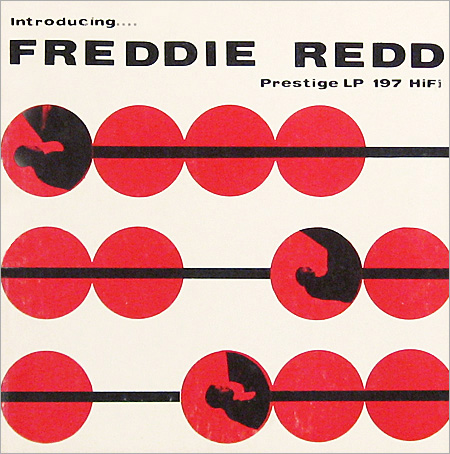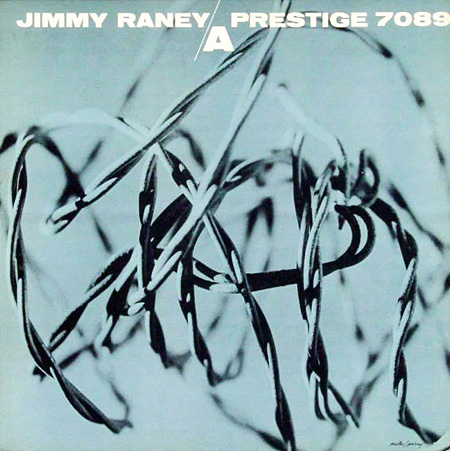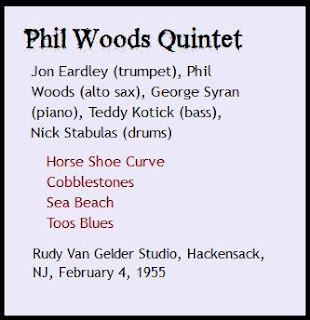Freddie Redd is probably best known for Jack Gelber's 1959 play about junkies waiting for their pusher Godot, The Connection. The play focused on a bunch of junkies sitting around a New York crash pad, waiting to get high. The cast includes four jazz musicians, most notably Redd and Jackie McLean. Gelber's original script had called for the musicians to just be sitting around noodling odd scraps of music, but Redd convinced the playwright to let him compose a real score. This was a good idea for all sorts of reasons. It was certainly stronger artistically. It was better for Freddie, because a composition meant steady...income, that is. Beyond what he was getting for acting, which in those days Off Broadway was not much. When you think about it, whatever the producers paid Freddie for the score, it was a good investment, because if the quartet had just had to sit around noodling night after night,,they would have been noodling something, and ASCAP would  have been on them like a ton of bricks.
have been on them like a ton of bricks.
The Connection was made into a movie by Shirley Clarke, with Redd again featured, and an album of the music from the play was released on Blue Note, but none of this made Redd into a star of the jazz world. If you were to mention his name to someone from that era--like me, for instance--you'd probably get "Oh, yeah, The Connection. Did he ever do anything else?" And because in The Connection, he plays a heroin addict, the person you were talking to would probably assume he had died young.
In fact, Redd is still with us, and as recently at 2013, according to his Facebook page, he was performing in Baltimore (his Facebook page only has 683 likes -- not enough).
But let's get back to this single session of four tunes for Prestige. His playing is simple and complex. straightforward and adventurous, bluesy and boppish. It engages the mind and goes straight to the heart. "Debut" is ornate in the manner of Bud Powell or even Art Tatum. In "Blues for Lady J" he plays the blues, elaborates on the blues, returns to the blues. "The Things We Did Last Summer" is a 1946 hit for Jo Stafford, by Sammy Cahn and Jule Styne, that's become a jazz standard. Redd gives it a beautiful, moody rendition that stays close to the melody but always offers something more. It comes in at just under six minutes, which gives Redd plenty of space to explore all its possibilities. "Ready Freddie" is taken at a faster tempo, and is a bravura piece for the pianist.
The trio is filled out by stellar musicians. John Ore worked with
:format(jpeg):mode_rgb()/discogs-images/R-852546-1301385089.jpeg.jpg) several of the best piano players of his time, including Bud Powell, Elmo Hope, Earl Hines, and most significantly Thelonious Monk, from 1960-63. Ron Jefferson and Ore both played with Lester Young, and Jefferson also backed up Coleman Hawkins, Roy Eldridge and Oscar Pettiford, among others. He was one of the original members of Les McCann's trio.
several of the best piano players of his time, including Bud Powell, Elmo Hope, Earl Hines, and most significantly Thelonious Monk, from 1960-63. Ron Jefferson and Ore both played with Lester Young, and Jefferson also backed up Coleman Hawkins, Roy Eldridge and Oscar Pettiford, among others. He was one of the original members of Les McCann's trio.
Ore has some solo space on both "Things We Did Last Summer" and "Blues for Lady J," and he takes full advantage of it. He also does some wonderful duet work with Redd on "Ready Freddie."
These tunes appear on a 10-inch LP, Introducing...Freddie Redd. There wasn't enough material for a 12-inch LP, so Prestige combined them with a Hampton Hawes session as Piano: East/West.
All can be heard on Spotify. I trust I don't need to tell you to listen. And if he gets booked at the Falcon, in my neck of the woods, I'm going.
 have been on them like a ton of bricks.
have been on them like a ton of bricks.The Connection was made into a movie by Shirley Clarke, with Redd again featured, and an album of the music from the play was released on Blue Note, but none of this made Redd into a star of the jazz world. If you were to mention his name to someone from that era--like me, for instance--you'd probably get "Oh, yeah, The Connection. Did he ever do anything else?" And because in The Connection, he plays a heroin addict, the person you were talking to would probably assume he had died young.
 |
| The Connection |
In fact, Redd is still with us, and as recently at 2013, according to his Facebook page, he was performing in Baltimore (his Facebook page only has 683 likes -- not enough).
But let's get back to this single session of four tunes for Prestige. His playing is simple and complex. straightforward and adventurous, bluesy and boppish. It engages the mind and goes straight to the heart. "Debut" is ornate in the manner of Bud Powell or even Art Tatum. In "Blues for Lady J" he plays the blues, elaborates on the blues, returns to the blues. "The Things We Did Last Summer" is a 1946 hit for Jo Stafford, by Sammy Cahn and Jule Styne, that's become a jazz standard. Redd gives it a beautiful, moody rendition that stays close to the melody but always offers something more. It comes in at just under six minutes, which gives Redd plenty of space to explore all its possibilities. "Ready Freddie" is taken at a faster tempo, and is a bravura piece for the pianist.
The trio is filled out by stellar musicians. John Ore worked with
:format(jpeg):mode_rgb()/discogs-images/R-852546-1301385089.jpeg.jpg) several of the best piano players of his time, including Bud Powell, Elmo Hope, Earl Hines, and most significantly Thelonious Monk, from 1960-63. Ron Jefferson and Ore both played with Lester Young, and Jefferson also backed up Coleman Hawkins, Roy Eldridge and Oscar Pettiford, among others. He was one of the original members of Les McCann's trio.
several of the best piano players of his time, including Bud Powell, Elmo Hope, Earl Hines, and most significantly Thelonious Monk, from 1960-63. Ron Jefferson and Ore both played with Lester Young, and Jefferson also backed up Coleman Hawkins, Roy Eldridge and Oscar Pettiford, among others. He was one of the original members of Les McCann's trio.Ore has some solo space on both "Things We Did Last Summer" and "Blues for Lady J," and he takes full advantage of it. He also does some wonderful duet work with Redd on "Ready Freddie."
These tunes appear on a 10-inch LP, Introducing...Freddie Redd. There wasn't enough material for a 12-inch LP, so Prestige combined them with a Hampton Hawes session as Piano: East/West.
All can be heard on Spotify. I trust I don't need to tell you to listen. And if he gets booked at the Falcon, in my neck of the woods, I'm going.









